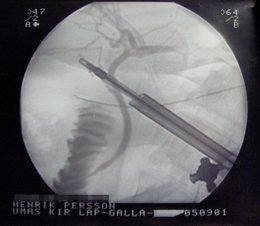Acute cholecystitis accounts for about 9 percent of hospital admissions for acute abdominal pain. Because the clinical presentation of cholecystitis may be inconsistent, sonographic findings such as visualization of stones, measurement of gall bladder wall thickness, and gallbladder distention commonly are used in making the diagnosis. Bingener and colleagues studied the correlation of specific ultrasonographic findings with the diagnosis at surgery in patients with suspected cholecystitis.
They studied patients admitted to a university hospital because of suspected acute cholecystitis. Eligible patients had significant constant upper right quadrant pain, fever, nausea, vomiting, and elevated white blood cell counts. Diagnostic ultrasound images were independently reviewed by two radiologists before the patients underwent laparoscopic cholecystectomy. Surgery was performed within 48 hours, and the surgical and histologic findings were compared with the ultrasonography results.
The mean age of the 47 women and eight men in the study was 37 years. The correlation of ultrasonography and surgical findings was strongest with the presence of gallstones (see accompanying table). False-positive results for gallstones occurred in three patients (5.5 percent), and a false-negative result occurred in one patient (1.8 percent). The overall sensitivity for the presence of stones was 98 percent. Although ultrasonography predicted one stone in seven patients, a solitary stone was found at surgery in five cases and in 12 histologic specimens. Ultrasonography was a poor predictor of hydrops or severely distended gallbladder. At surgery, 17 patients had severe hydrops, and 26 showed
some degree of hydrops, but only four cases were anticipated based on the sonogram. Similarly, ultrasound imaging only moderately predicted gallbladder wall thickening. Correlation with wall thickness at pathology was complicated by specimen dehydration in formaldehyde. Overall, ultrasound examination diagnosed 24 patients as having acute cholecystitis; but at surgery, 15 patients had severe inflammation, nine had moderate inflammation, and 16 had early inflammatory changes. This correlates with a sensitivity of 60 percent if a sonographic Murphy's sign was reported (pain when the ultrasound probe was passed over the gallbladder) and a sensitivity of 54 percent if the radiologist was not aware of this finding. The specificity for acute cholecystitis diagnosed on ultrasound examination was 77 percent compared with surgical findings and 71 percent compared with histology.
The authors conclude that ultrasonography has limited ability to predict acute cholecystitis, but that it is highly sensitive in the detection of gallstones.
ANNE D. WALLING, M.D.
Bingener J, et al. Does the correlation of acute cholecystitis on ultrasound and at surgery reflect a mirror image? Am J Surg December 2004;188:703-7.
COPYRIGHT 2005 American Academy of Family Physicians
COPYRIGHT 2005 Gale Group



